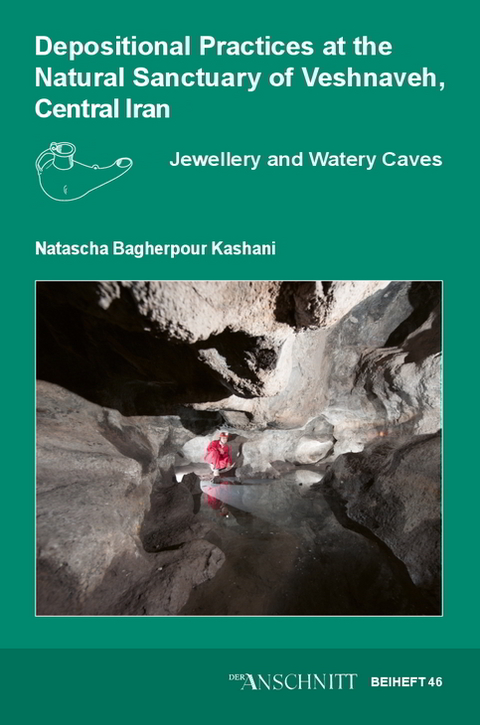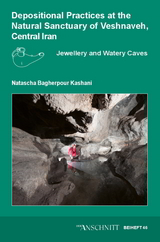Veröffentlichungen aus dem Deutschen Bergbau-Museum Bochum / Depositional Practices at the Natural Sanctuary of Veshnaveh, Central Iran
Jewellery and Watery Caves. Mining Archaeology in Iran 1. Research in Veshnaveh 1
Seiten
2022
VML Vlg Marie Leidorf (Verlag)
978-3-86757-040-4 (ISBN)
VML Vlg Marie Leidorf (Verlag)
978-3-86757-040-4 (ISBN)
Von 2000 bis 2005 untersuchte das Team des Deutschen Bergbau-Museums gemeinsam mit den iranischen Kollegen das prähistorische Kupferabbaugebiet in der Nähe des Dorfes Veshnaveh in den Bergen des Zentraliran. Zwei Gruben, Chale Ghar 1 und 2, die durch den Kupferabbau ausgehöhlt worden waren, waren mit dem Wasser der Schneeschmelze gefüllt worden. Dort wurden Objekte freigelegt, die jedoch in keinem Zusammenhang mit prähistorischen Bergbauaktivitäten stehen: Darunter befanden sich Keramiken, aber auch sehr gut erhaltene Tierknochen, Früchte und Samen, Holzgefäße sowie Schmuck und persönliche Ornamente. Die Ansammlung und die Art und Weise, wie die Objekte deponiert worden waren, unterstützen die Annahme, dass die Gruben wahrscheinlich als Naturheiligtum gedient hatten. Unterstützt durch eine 14C-Untersuchung von Holzkohle, die am Boden der Ablagerungen gesammelt wurde, und durch den Fund einer Münze aus der Zeit des Kalifats der Umayyaden, ist anzunehmen, dass die Nutzung von Chale Ghar 1 - außerhalb der Bergbauaktivitäten - von ca. 800 v.u.Z. bis ins 8. Jh. u.Z. stattfand. Die vorliegende Arbeit beschäftigt sich mit der Einordnung der Schmuckfunde, deren möglichen Imports und Handel, der Deponierungspraxis und Aspekten zu vorislamischen religiösen Handlungen und religiös Handelnden.
Between 2000 and 2005 alongside their Iranian colleagues, the team from the German Mining Museum examined the prehistoric copper-mining area located close to the village of Veshnaveh in the mountains of central Iran. Two mines, Chale Ghar 1 and 2, which had been hollowed out by copper-mining activities, had been filled with the water from melting snow. There objects were uncovered unrelated to prehistoric mining activities: among them were ceramics, as well as very well preserved animal bones, fruits and seeds, wooden vessels, as well as jewellery and personal ornaments. The assemblage and the way in which the objects had been disposed support the assumption that the mines had probably served as a natural sanctuary. Aided by a 14C examination of charcoal collected at the bottom of the depositional features, and by the discovery of an Umayyad coin, it is sensible to assume that the use of Chale Ghar 1 – outside mining activities– ran from c. 800 B.C. to the 8th century A.D. The present study deals with the classification of the personal ornaments, their possible import and trade, the depositional practice and aspects of pre-Islamic religious acts and religious actors. Between 2000 and 2005 alongside their Iranian colleagues, the team from the German Mining Museum examined the prehistoric copper-mining area located close to the village of Veshnaveh in the mountains of central Iran. Two mines, Chale Ghar 1 and 2, which had been hollowed out by copper-mining activities, had been filled with the water from melting snow. There objects were uncovered unrelated to prehistoric mining activities: among them were ceramics, as well as very well preserved animal bones, fruits and seeds, wooden vessels, as well as jewellery and personal ornaments. The assemblage and the way in which the objects had been disposed support the assumption that the mines had probably served as a natural sanctuary. Aided by a 14C examination of charcoal collected at the bottom of the depositional features, and by the discovery of an Umayyad coin, it is sensible to assume that the use of Chale Ghar 1 – outside mining activities– ran from c. 800 B.C. to the 8th century A.D. The present study deals with the classification of the personal ornaments, their possible import and trade, the depositional practice and aspects of pre-Islamic religious acts and religious actors.
Between 2000 and 2005 alongside their Iranian colleagues, the team from the German Mining Museum examined the prehistoric copper-mining area located close to the village of Veshnaveh in the mountains of central Iran. Two mines, Chale Ghar 1 and 2, which had been hollowed out by copper-mining activities, had been filled with the water from melting snow. There objects were uncovered unrelated to prehistoric mining activities: among them were ceramics, as well as very well preserved animal bones, fruits and seeds, wooden vessels, as well as jewellery and personal ornaments. The assemblage and the way in which the objects had been disposed support the assumption that the mines had probably served as a natural sanctuary. Aided by a 14C examination of charcoal collected at the bottom of the depositional features, and by the discovery of an Umayyad coin, it is sensible to assume that the use of Chale Ghar 1 – outside mining activities– ran from c. 800 B.C. to the 8th century A.D. The present study deals with the classification of the personal ornaments, their possible import and trade, the depositional practice and aspects of pre-Islamic religious acts and religious actors. Between 2000 and 2005 alongside their Iranian colleagues, the team from the German Mining Museum examined the prehistoric copper-mining area located close to the village of Veshnaveh in the mountains of central Iran. Two mines, Chale Ghar 1 and 2, which had been hollowed out by copper-mining activities, had been filled with the water from melting snow. There objects were uncovered unrelated to prehistoric mining activities: among them were ceramics, as well as very well preserved animal bones, fruits and seeds, wooden vessels, as well as jewellery and personal ornaments. The assemblage and the way in which the objects had been disposed support the assumption that the mines had probably served as a natural sanctuary. Aided by a 14C examination of charcoal collected at the bottom of the depositional features, and by the discovery of an Umayyad coin, it is sensible to assume that the use of Chale Ghar 1 – outside mining activities– ran from c. 800 B.C. to the 8th century A.D. The present study deals with the classification of the personal ornaments, their possible import and trade, the depositional practice and aspects of pre-Islamic religious acts and religious actors.
| Erscheinungsdatum | 10.04.2022 |
|---|---|
| Reihe/Serie | Der ANSCHNITT ; 46 | Veröffentlichungen aus dem Deutschen Bergbau-Museum Bochum ; 247 |
| Co-Autor | James Lankton, Bernard Gratuze |
| Verlagsort | Rahden |
| Sprache | englisch |
| Maße | 210 x 298 mm |
| Gewicht | 1610 g |
| Einbandart | gebunden |
| Themenwelt | Geschichte ► Allgemeine Geschichte ► Vor- und Frühgeschichte |
| Schlagworte | Frühislamisch • Glas • Heiligtum • Höhle • Kupferabbau • Perlen |
| ISBN-10 | 3-86757-040-X / 386757040X |
| ISBN-13 | 978-3-86757-040-4 / 9783867570404 |
| Zustand | Neuware |
| Haben Sie eine Frage zum Produkt? |
Mehr entdecken
aus dem Bereich
aus dem Bereich
auf den Spuren der frühen Zivilisationen
Buch | Hardcover (2023)
C.H.Beck (Verlag)
20,00 €
Was Pompeji über uns erzählt
Buch | Hardcover (2023)
Propyläen (Verlag)
32,00 €




